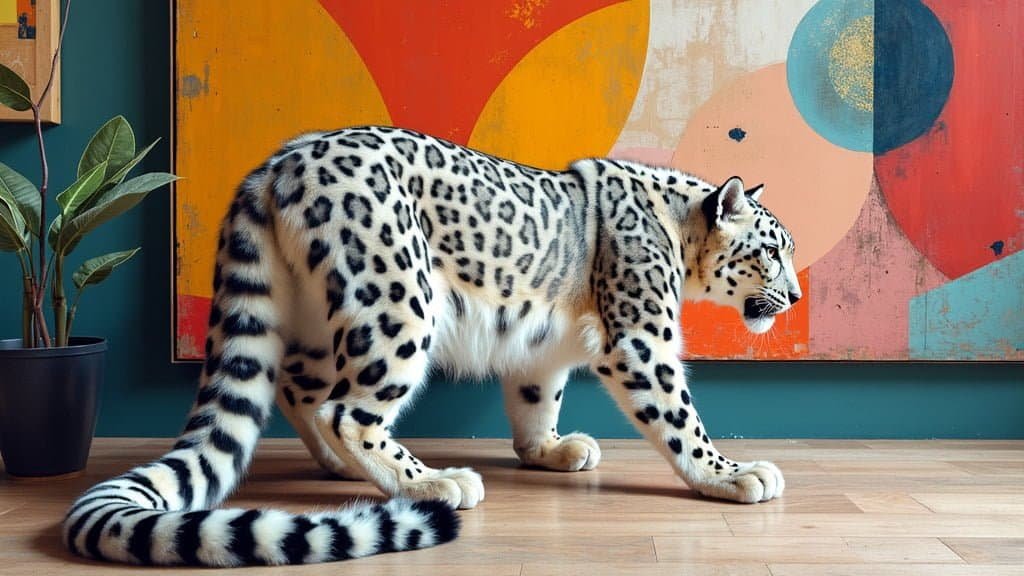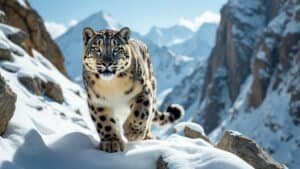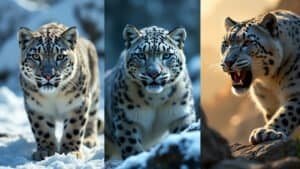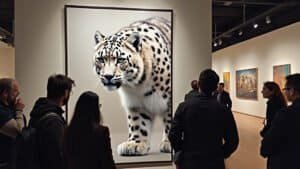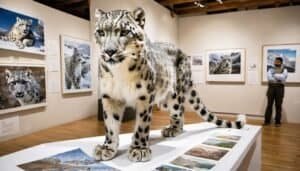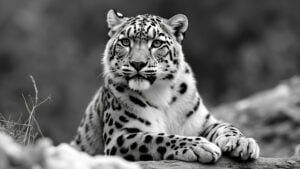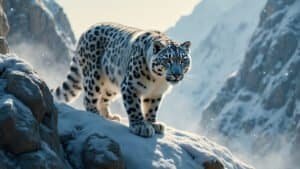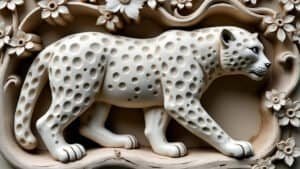Introduction
Snow leopards have become powerful symbols in contemporary art, representing more than just their physical beauty. Artists across various mediums are drawn to the mystique, grace, and endangered status of these elusive creatures
This article explores the many ways snow leopards inspire modern art, from their symbolic significance to the materials and techniques artists use to capture their essence
We will also delve into the artists who prominently feature snow leopards in their work, the influence of their natural habitats, and the broader cultural meanings they evoke in today’s art scene
Symbolism of Snow Leopards in Contemporary Art
Snow leopards are not just admired for their physical beauty and elusive nature; they have also become potent symbols in contemporary art, embodying themes that resonate deeply within modern society
These majestic creatures are often used to explore ideas of mystery, solitude, and resilience, reflecting the challenges of survival in an ever-changing world. Their endangered status adds another layer of meaning, as artists use them to comment on environmental issues and the fragility of life on Earth
This section delves into the different symbolic roles snow leopards play in contemporary art, exploring their cultural significance, their representation in environmental art, and the deeper meanings they convey
The Mystique of the Snow Leopard in Art
Snow leopards are often depicted as symbols of mystery and grace in contemporary art. Their elusive nature, as they dwell in remote and rugged mountain ranges, makes them a symbol of the unknown and the unattainable
Artists use snow leopards to evoke a sense of wonder and curiosity, often placing them in surreal or abstract settings that emphasize their otherworldly presence. The snow leopard’s pale, spotted coat is frequently stylized in artwork, sometimes abstracted into patterns that blend into the surrounding environment, further enhancing the creature’s mysterious aura
In contemporary art, the snow leopard often represents solitude and introspection. Its solitary nature in the wild is mirrored in art as a symbol of inner strength and self-reliance
Artists may use the image of the snow leopard to explore themes of isolation, both as a personal experience and as a commentary on the increasingly disconnected world we live in. This interpretation can be seen in various forms, from paintings and drawings to sculptures that capture the essence of the snow leopard’s silent yet powerful presence
Cultural Significance in Modern Artistic Expression
The cultural significance of snow leopards extends beyond their physical attributes and into the realm of myth and legend. In many cultures, particularly in Central and South Asia, snow leopards are revered as sacred animals
They are often associated with spiritual qualities, such as wisdom, protection, and guardianship. Contemporary artists tap into these cultural narratives, using the snow leopard as a bridge between the natural world and spiritual or mystical realms
In some works, snow leopards are depicted alongside human figures or in contexts that suggest a connection between humanity and the animal world. This relationship is often portrayed as one of mutual respect and understanding, highlighting the importance of coexistence and the deep bonds that can form between species
Such artwork may draw on traditional stories and beliefs, reinterpreting them in a modern context to comment on contemporary issues like conservation and the human impact on the environment
The Role of Snow Leopards in Environmental Art
Environmental art has become a significant movement within contemporary art, and the snow leopard frequently appears as a central figure in this genre. As an endangered species, snow leopards symbolize the broader struggle of wildlife against the threats of climate change, habitat destruction, and poaching
Artists who focus on environmental themes often use the snow leopard to raise awareness about these issues, creating works that not only celebrate the beauty of this animal but also serve as calls to action
The depiction of snow leopards in environmental art can take many forms, from realistic portrayals that highlight their vulnerable status to more abstract interpretations that convey a sense of loss or urgency
Some artists use the snow leopard to represent the fragility of ecosystems, placing them in scenes that show the stark contrast between the natural world and human encroachment. Others may use mixed media or installation art to create immersive experiences that bring viewers face-to-face with the challenges snow leopards face in the wild
In this context, the snow leopard is more than just a subject; it becomes a symbol of the interconnectedness of all life and the responsibility humans have to protect the planet’s most vulnerable species. By focusing on the snow leopard, artists can draw attention to the broader environmental crisis, using their work to inspire change and encourage a more sustainable relationship with nature
Artists Who Feature Snow Leopards in Their Work
Snow leopards have captured the imaginations of many contemporary artists, inspiring a diverse range of works across different mediums. From traditional painting to digital art, these elusive creatures are celebrated for their beauty, strength, and the powerful symbolism they carry
This section explores notable artists who have prominently featured snow leopards in their work, highlighting the various ways they have depicted these animals. We’ll examine the contributions of painters, sculptors, and digital artists who have brought the snow leopard to life in their art, showcasing the diverse approaches and techniques they employ
Prominent Contemporary Painters and Illustrators
Several contemporary painters and illustrators have made snow leopards central to their work, often using these animals to convey deeper messages about nature and humanity
Artists such as Robert Bateman, known for his wildlife art, have created stunningly realistic depictions of snow leopards, capturing their elusive nature and the harsh environments they inhabit. Bateman’s work often emphasizes the beauty and fragility of these animals, serving as a visual reminder of the importance of conservation
Illustrators like Charley Harper have taken a more stylized approach, using geometric shapes and bold colors to represent the snow leopard. Harper’s minimalistic style strips down the form of the snow leopard to its essential elements, yet retains its distinctive characteristics, making his work both modern and timeless
His art appeals to those who appreciate wildlife in a more abstract and playful manner, offering a unique interpretation of the snow leopard that resonates with contemporary audiences
Other artists, such as Dave White, bring a dynamic and expressive quality to their paintings of snow leopards. White’s use of energetic brushstrokes and vivid colors creates a sense of movement and life, capturing the raw power and grace of these animals
His work often blurs the line between realism and abstraction, allowing viewers to connect with the emotion and spirit of the snow leopard rather than just its physical appearance
Snow Leopards in Sculpture and Installations
Sculptors and installation artists have also been drawn to the snow leopard, using a variety of materials and techniques to explore its form and symbolism. British sculptor Hamish Mackie, for instance, is renowned for his bronze wildlife sculptures, which include lifelike representations of snow leopards
Mackie’s attention to detail and his ability to capture the essence of the animal in motion make his sculptures particularly striking. His work often evokes the natural habitats of snow leopards, with pieces that convey a sense of the wild landscapes they inhabit
Installation artists like Cai Guo-Qiang have approached the snow leopard from a more conceptual angle. In his work “Heritage,” Guo-Qiang used taxidermy animals, including snow leopards, to create a poignant commentary on the relationship between humans and the natural world. His installations often provoke reflection on the impact of human activity on wildlife, using the snow leopard as a symbol of both beauty and loss
These sculptural and installation works are often displayed in public spaces or galleries, where they engage viewers on a physical level
The tactile nature of sculpture allows for a different kind of interaction with the snow leopard, inviting viewers to consider the texture, form, and presence of the animal in a three-dimensional space. This approach brings the snow leopard to life in a way that is both tangible and evocative, highlighting its role as a symbol of wildness and resilience
Digital and Multimedia Art Representations
The rise of digital and multimedia art has provided new avenues for artists to explore the snow leopard as a subject. Digital artists like Andreas Lie have used techniques such as double exposure photography to create surreal and captivating images of snow leopards
Lie’s work often blends the animal with its natural environment, creating a seamless connection between the creature and its habitat. This approach emphasizes the snow leopard’s role as a part of the larger ecosystem, reinforcing the importance of preserving its environment
Multimedia artists like Cory Trepanier combine traditional painting with digital tools to create immersive experiences that transport viewers into the world of the snow leopard
Trepanier’s work often involves extensive field research, including expeditions to the snow leopard’s natural habitats, which he then incorporates into his art. His multimedia projects may include video, sound, and interactive elements that allow viewers to engage with the snow leopard in a dynamic and multi-sensory way
These digital and multimedia representations are particularly effective at reaching a broad audience, as they can be shared widely through social media and online platforms
They also offer new possibilities for storytelling, allowing artists to create complex narratives around the snow leopard that can evolve over time. This form of art not only celebrates the snow leopard but also educates and inspires action, using technology to bridge the gap between art and activism
Techniques and Materials Used to Depict Snow Leopards
Artists who depict snow leopards in contemporary art employ a wide range of techniques and materials, each chosen to capture different aspects of the animal’s character, environment, and symbolism
The methods vary greatly depending on the medium, whether it’s traditional painting, sculpture, or cutting-edge digital art. This section delves into the diverse approaches artists use, from classical techniques to innovative digital methods, highlighting how these choices influence the portrayal of snow leopards in art
Traditional Painting and Drawing Techniques
Traditional painting and drawing remain popular methods for depicting snow leopards, with artists often choosing mediums like oil, watercolor, acrylics, and charcoal to create detailed and lifelike images
Oil painting, for example, allows for rich textures and deep, vibrant colors that bring out the intricate patterns of the snow leopard’s fur. Artists like Anselm Kiefer and Robert Bateman have used oil paints to render the majestic appearance of snow leopards, focusing on the play of light and shadow to convey the animal’s elusive presence
Watercolor and ink, on the other hand, offer a more fluid and expressive way to capture the essence of the snow leopard. These mediums are often used in a more minimalist style, with artists focusing on the grace and movement of the animal
The transparency of watercolor allows for subtle layering of color, which can create a sense of depth and atmosphere, making it ideal for depicting the snow leopard’s natural, often mist-shrouded, mountainous habitats
Charcoal and pencil drawings are also widely used, particularly for their ability to capture fine details and textures. The monochromatic nature of these mediums can evoke the stark, cold environments in which snow leopards live, emphasizing their resilience and solitary nature
The contrast and shading achieved with charcoal and pencil can highlight the snow leopard’s musculature and fur, giving a sense of the animal’s strength and agility
Sculptural Approaches and Materials
In sculpture, the depiction of snow leopards can range from highly realistic to abstract interpretations, depending on the materials and techniques used
Bronze is a traditional material favored by sculptors like Hamish Mackie, who use it to create lifelike representations of snow leopards that capture their physical power and elegance. The patina that develops on bronze over time can also add a sense of age and history to the piece, making it feel timeless
Stone and marble are other materials often used in sculpture, allowing artists to carve intricate details that highlight the snow leopard’s features
These materials are chosen for their durability and the sense of permanence they convey, which can be symbolic of the snow leopard’s ancient lineage and enduring presence in the wild. The weight and solidity of stone and marble also contrast with the delicate and fleeting nature of the snow leopard, creating a tension that adds depth to the artwork
More contemporary approaches might include the use of mixed media, combining traditional materials like bronze or wood with newer ones such as resin, glass, or recycled materials
This blend of old and new techniques can reflect the changing nature of the snow leopard’s environment, impacted by modern challenges like climate change and habitat loss. Some artists may even incorporate elements from the natural world, such as stones or branches from the snow leopard’s habitat, to create a direct connection between the artwork and the animal’s ecosystem
Innovative Digital Art Techniques
The advent of digital art has opened up new possibilities for depicting snow leopards, allowing artists to experiment with techniques that are not possible in traditional media
Digital painting and illustration software such as Adobe Photoshop and Procreate offer tools that mimic traditional brushes and textures, enabling artists to create detailed and complex images of snow leopards with a high degree of precision. This digital flexibility allows for experimentation with color, composition, and lighting in ways that can bring out new interpretations of the snow leopard’s image
Photographic manipulation is another popular technique, where artists like Andreas Lie use double exposure or layering effects to merge images of snow leopards with their natural environments
This method creates a surreal, dreamlike quality that emphasizes the connection between the animal and its surroundings. By digitally blending textures, colors, and patterns, artists can create works that challenge the viewer’s perception of reality, making the snow leopard appear both familiar and fantastical
Virtual and augmented reality (VR/AR) are cutting-edge technologies that some artists are beginning to explore, offering immersive experiences that bring viewers closer to the snow leopard’s world
These technologies allow for interactive art pieces where viewers can engage with digital representations of snow leopards in three-dimensional space, often in environments that mimic the animals’ natural habitats. This approach not only provides a new way to experience art but also serves as an educational tool, raising awareness about the snow leopard and the challenges it faces in the wild
These innovative digital techniques are often shared and distributed online, reaching a global audience and contributing to the growing visibility of the snow leopard in contemporary art. By utilizing digital platforms, artists can create and share works that transcend traditional boundaries, making the snow leopard a symbol of both artistic creativity and environmental consciousness in the digital age
The Influence of Snow Leopard Habitats on Art
The rugged, remote habitats of snow leopards play a significant role in how these animals are depicted in contemporary art
The natural environment of the snow leopard, characterized by vast mountain ranges, harsh climates, and breathtaking landscapes, not only provides a dramatic backdrop for their portrayal but also influences the themes and materials used by artists
This section explores how the unique habitats of snow leopards inspire and shape their representation in art, from the depiction of mountainous landscapes to the use of natural textures and the symbolism of pristine environments
Depicting the Mountain Landscapes
Snow leopards are most commonly found in the high-altitude regions of Central and South Asia, including the Himalayas, the Tibetan Plateau, and the Altai Mountains
These awe-inspiring landscapes, with their towering peaks, deep valleys, and snow-covered terrain, are often integral to the portrayal of snow leopards in art. Artists frequently incorporate these elements into their work to evoke the wild and untamed nature of the snow leopard’s environment
Painters like Nicholas Roerich, known for his depictions of the Himalayas, have captured the mystical and spiritual essence of these landscapes, often placing snow leopards within these settings to highlight their connection to these remote regions
The vastness and isolation of the mountains reflect the elusive nature of the snow leopard, while the harsh conditions underscore the animal’s resilience and adaptability. These landscape elements serve not only as a physical backdrop but also as a metaphor for the challenges and solitude that snow leopards face in the wild
Artists may also focus on specific features of the snow leopard’s habitat, such as the steep cliffs and rocky outcrops where these animals are often found
These settings are depicted with meticulous attention to detail, emphasizing the snow leopard’s agility and ability to navigate such treacherous terrain. The ruggedness of the landscape is often mirrored in the texture and composition of the artwork, with rough brushstrokes, bold lines, or sculptural forms that evoke the craggy mountainsides and the cold, stark beauty of the snow leopard’s home
Integrating Natural Textures and Elements
In addition to depicting the physical landscape, many artists integrate natural textures and materials into their work to capture the essence of the snow leopard’s environment
This approach not only enhances the realism of the depiction but also creates a tactile connection between the viewer and the subject. For example, artists may use materials such as stone, wood, or metal to replicate the textures of the snow leopard’s mountainous habitat, adding depth and dimension to their pieces
Textural techniques are particularly evident in sculpture, where the roughness of stone or the smoothness of bronze can be used to evoke the surfaces of the mountains and the softness of the snow leopard’s fur
Some artists even incorporate natural elements directly into their work, such as pebbles, branches, or snow, blurring the line between art and nature. This integration of real-world materials helps to create a more immersive experience, inviting viewers to engage with the artwork on a sensory level
In paintings and drawings, artists may use layering techniques to build up textures that mimic the rocky, snow-covered terrain. The use of impasto, where paint is applied thickly to create a three-dimensional surface, can suggest the roughness of the mountain slopes or the cold, dense snow in which the snow leopard treads
These textural elements add a sense of realism and immediacy to the artwork, making the viewer feel as though they are encountering the snow leopard in its natural environment
Symbolism of Remote and Pristine Environments
The remote and pristine environments that snow leopards inhabit also carry symbolic weight in contemporary art
These settings are often depicted as untouched, pure landscapes, representing a world that is increasingly rare and under threat from human encroachment. The snow leopard, as a denizen of these distant places, becomes a symbol of the wilderness and the need to preserve it
Artists who focus on environmental themes often use the snow leopard’s habitat to comment on the broader issues of conservation and the impact of climate change. The depiction of pristine landscapes, free from human interference, serves as a reminder of what is at stake if these environments are not protected
In this context, the snow leopard is not just an animal but a guardian of these sacred spaces, embodying the natural beauty and fragility of the world’s last wild places
Some artists may take a more abstract approach, using the idea of remoteness and isolation as a metaphor for the challenges facing both the snow leopard and the environment. These works might depict the snow leopard as a solitary figure against a vast, empty landscape, emphasizing themes of loneliness and vulnerability
The use of minimalist compositions, with sparse elements and muted colors, can convey the starkness of these environments and the existential threats that snow leopards face in a rapidly changing world
The portrayal of snow leopard habitats in art thus goes beyond mere representation; it becomes a powerful tool for storytelling and advocacy. By highlighting the beauty and uniqueness of these environments, artists draw attention to the urgent need for conservation and the protection of endangered species like the snow leopard
Through their work, they encourage viewers to consider their own relationship with nature and the role they play in preserving it for future generations
Conclusion
Throughout contemporary art, snow leopards have emerged as powerful symbols of mystery, resilience, and the untamed beauty of the natural world. Their portrayal in art is not just about capturing their physical form, but also about conveying deeper themes that resonate with both artists and audiences
From the mystical and cultural significance they hold to their role in environmental art, snow leopards inspire a wide range of creative expressions. Artists across different mediums, from traditional painters to digital innovators, have found ways to incorporate the snow leopard’s unique characteristics and habitat into their work, often using these elements to comment on broader social and environmental issues
The use of diverse techniques and materials further enhances the representation of snow leopards, allowing them to be depicted in ways that are both visually striking and thematically rich. As a symbol of the wild and the endangered, the snow leopard continues to captivate the world of contemporary art, reminding us of the delicate balance between nature and human impact
